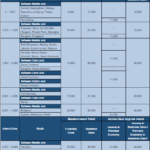Let’s face it: stretching our dollars feels like a never-ending game of financial Jenga. One wrong move and the whole tower comes crashing down. But fear not! I’ve pulled together these 11 savvy strategies to help you save more without sacrificing the things that truly matter.
These top 10 strategies will help you gain the mindset of “spending less saving more” this year. These tips aren’t just practical—they’re fun and easy to implement. Let’s dive in!

1. Track Your Spending
First thing’s first, staying on track with your financial goals requires regular monitoring and adjustments. It’s not enough to set up a plan—you need to stick with it and make necessary changes along the way. Let’s discuss how to keep your finances on the right path.
Document all your purchases, no matter how small, and organize them by category. This helps you see where your money is going and identify areas where you can cut back.
A report by the Federal Reserve shows that individuals who track their spending money are more likely to stick to their budget and save money.
Take Advantage of Tools
There are many tools available to help you track your spending, from apps to simple spreadsheets. Find a method that works for you and make it a habit to record your expenses daily. Review your spending regularly to spot patterns and identify areas where you can cut back.
This practice not only helps you stay on budget but also makes you more aware of your spending habits.
2. Create a Budget That Works for You
Next, let’s talk budgets. It’s essential to know exactly how much money you have and where it’s going. A recent study by the Rutgers Cooperative Extension found that people who create and stick to a budget are 82% more likely to achieve their financial goals.
They said, “What to do? Develop a money-saving mindset. What this means is setting overall limits for spending and finding ways to live within your plan. The most common ways of doing this are increasing income, reducing expenses, or doing a little of both.”
Set Savings Goals
Setting specific savings goals gives you a clear target to aim for. Research from the Sage Journals shows that people who set specific savings goals save 31% more than those who don’t. Whether it’s a vacation, a new gadget, or an emergency fund, write down your goal and the deadline. Use a savings tracker to monitor your progress and keep the momentum going.
To make your goals more effective, use the SMART criteria: Specific, Measurable, Achievable, Relevant, and Time-bound.
For example, instead of saying, “I want to save money,” set a goal like, “I want to save $5,000 for a vacation in 12 months.” This gives you a clear target and timeframe, making it easier to stay motivated. Regularly review your goals and adjust your plans as needed to stay on track.

50/30/20 Rule
One of the best methods is the 50/30/20 rule: allocate 50% of your income to needs, 30% to wants, and 20% to savings and debt repayment. Trust me, this rule can work wonders in keeping your finances in check.
- Start by listing all your sources of income.
- Next, track your expenses for a month to see where your money is going.
- Categorize your spending into living expenses (like rent, electric bill, cell phone plan, utilities, grocery shopping), wants (like dining out, entertainment), and savings or debt repayment.
- Adjust your spending to fit within the 50/30/20 framework.
Keep in mind that this rule can be adjusted based on your unique income levels and financial goals. For example, if you have high debt or significant savings goals, you might allocate more than 20% toward savings and debt repayment. Alternatively, if you’re working with a lower income, focusing more on necessities (over 50%) may be necessary while still finding ways to save. Sticking to your budget requires regular monitoring, using tools like budgeting apps, and setting realistic, achievable goals to stay motivated and disciplined over time.
This process may seem tedious at first, but it’s a crucial step toward financial clarity and control. Plus, you’ll be surprised at how much more in control you’ll feel once you have a clear picture of your finances.

3. Save on Everyday Essentials
Everyday expenses can add up quickly, but there are plenty of ways to save without sacrificing your quality of life. Let’s explore some simple yet effective strategies to cut costs on daily essentials.
Start Saving Money on Groceries
Meal planning and grocery lists are your best friends when it comes to saving money on food. Plan your meals for the week, make a list, and stick to it. This avoids the pitfalls of impulse buys and drive-thru temptations.
- Start by checking what you already have at home to avoid buying duplicates. Plan meals around sales and seasonal produce to get the best deals.
- When shopping, stick to your list and avoid aisles that trigger impulse buys.
- Buying in bulk can also save money, but be sure to compare unit prices to ensure you’re getting the best deal.
Lastly, consider cooking in batches and freezing portions for future meals. This saves time and ensures you always have a home-cooked meal ready to go.
Lower Your Car Costs
Car costs can drain your budget, but there are ways to cut back. Consider refinancing your auto loan to take advantage of lower interest rates. Shop around for car insurance to find the best deal.
The Insurance Information Institute suggests that consumers can save up to $400 a year by comparing insurance rates.
Regular maintenance can also help you save money in the long run by preventing costly repairs. Keep your tires properly inflated, change your oil regularly, and follow your car’s maintenance schedule.
When it comes to insurance, don’t be afraid to ask about discounts. Many insurers offer discounts for good driving records, bundling policies, and even paying your premium annually instead of monthly.

Reduce Utility Bills
Reducing your utility bills doesn’t have to be complicated—it’s all about making small, smart changes that add up over time. Start by turning off lights, appliances, and electronics when they’re not in use. Unplugging devices can prevent “phantom” energy use, which is energy consumed even when something is turned off.
Consider setting your thermostat a few degrees higher in the summer or lower in the winter to cut heating and cooling costs. Ceiling fans and natural ventilation can help keep your home comfortable without overworking your AC or heater.
4. Cutting Back on Non-Essentials
To boost your savings, it’s crucial to cut back on unnecessary expenses. This doesn’t mean depriving yourself of all pleasures but being mindful of where your money goes. Let’s look at some practical ways to trim the fat from your budget.
Reduce Online Shopping
We’ve all fallen into the online shopping trap, but cutting back can significantly improve your spending habits. Try avoiding stores and websites that tempt you to overspend. Instead, fill your time with fun activities that don’t cost a dime—like hiking, reading, or a movie night at home. A study by the University of Pennsylvania found that reducing exposure to shopping stimuli can decrease unnecessary spending by 25%.
Online shopping can be a major budget buster. To curb this habit, unsubscribe from promotional emails and avoid browsing shopping sites when you’re bored.
Instead, create a list of free or low-cost activities you enjoy. By finding alternative ways to spend your time, you’ll be less tempted to make impulse purchases. And when you do need to shop, make a list and stick to it. This helps you stay focused and avoid unnecessary spending.

Minimize Restaurant Spending
Eating out is convenient but costly. You can save money and eat healthier by cooking at home. Pack your lunch for work and try new recipes for dinner. The Bureau of Labor Statistics reports that the average household spends over $3,000 a year on dining out. Imagine how much you could save by cooking more at home!
5. Automate Your Savings
One of the easiest ways to save money without even thinking about it is to automate your bank account. Set up your direct deposit to automatically transfer a portion of each paycheck into a high-yield savings account.
This way, you’re paying yourself first and you save money fast. People who automate their savings are 50% more likely to save consistently. Let’s make saving money a no-brainer!
Automation As Your Savings Partner
Automation takes the effort out of saving. By setting up automatic transfers, you remove the temptation to spend the money instead. Even if it’s a small amount, the key is consistency. Over time, those small deposits add up, helping you build a substantial savings cushion. With the money out of sight, you’re less likely to miss it in your daily spending.

6. Pay Off Debt Strategically
Making smart financial decisions is key to long-term financial health. By being strategic about how you handle your money, you can avoid debt and make the most of your hard-earned cash. Let’s look at some ways to be financially savvy.
Avoid Credit Card Debt
Credit card debt can be a financial black hole. Pay off high-interest debt quickly by making extra payments. Use the snowball or avalanche method to tackle your debt strategically. Investopedia shows that people using these methods pay off debt faster and more efficiently.
The snowball method involves paying off your smallest debts first, giving you quick wins and momentum. The avalanche method focuses on paying off the highest-interest debts first, saving you more money in the long run. Choose the method that works best for you and stick to it.
Do Not Add to Your Debt
Additionally, avoid adding or accumulating new debt by only using your credit card for planned purchases and paying off the balance in full each month. According to Investopedia, “Ideally, you want to pay off the debt with the highest interest rate first to save the most money. But if you find that paying off small debts motivates you to continue working toward reducing debt, you may want to pay those off first instead.”

7. Use Cash & Avoid Impulse Purchases
Using cash and avoiding impulse purchases are essential strategies for staying on top of your finances. By being mindful of how you spend and delaying unnecessary purchases, you can create better spending habits and keep more money in your pocket.
Stick to Cash for Everyday Expenses
Using cash for everyday purchases can help you be more mindful of your spending. When you physically see the money leaving your wallet, you’re less likely to make impulsive buys. Studies show that cash users spend less compared to those who rely on credit cards for daily expenses.
Implement the 30-Day Rule
Before making a non-essential, larger purchase, wait 30 days. This cooling-off period gives you time to assess whether you truly need the item or if it’s just a fleeting desire. More often than not, you’ll find that you can live without it.
Mindful Spending
Be intentional with your purchases. Focus on buying things that align with your values and needs, rather than giving in to instant gratification. By practicing mindfulness, you’ll resist temptation and make smarter choices that benefit your long-term financial goals.
8. Find Extra Sources of Income
Exploring side hustles is a great way to increase your income and achieve your financial goals faster. Here are some common ways to earn extra money:
- Freelance work: Offer your skills on platforms like Fiverr, Upwork, or Freelancer.
- Part-time gigs: Consider driving for rideshare services like Uber or delivering food with apps like DoorDash.
- Online tutoring or teaching: Use platforms like VIPKid or Tutor.com to teach others from the comfort of your home.
These side hustles allow you to leverage your skills and spare time to earn extra cash without a major commitment.
9. Long-Term Savings Strategies
By setting aside money for emergencies, retirement, and growth, you can create a financial safety net that will serve you for years to come.
- Build an emergency fund: Aim to save 3-6 months of living expenses to cover unexpected events or emergencies.
- Plan for retirement early: The earlier you start saving for retirement, the more you benefit from compound interest, leading to larger returns over time.
- Invest for growth: Explore low-risk investment options like mutual funds or bonds to help your money grow steadily while minimizing risk.
10. Advanced Tips for Saving More
Embrace your inner bargain hunter! Use cash-back apps and coupons to save money on everyday purchases. Be mindful of your spending and avoid buying things you don’t need. According to CNBC, coupon users save an average of $30 per week on groceries. That’s $1,560 a year!
Before making any purchase, check for discounts, deals, and cash-back offers. There are plenty of apps and websites that can help you find the best deals.
Don’t shy away from buying refurbished or gently used items. You can find quality products for a fraction of the price, whether it’s electronics, furniture, or even clothing. On top of that, take the time to negotiate your bills, like cable, internet, or insurance.

Wrapping Up on Spending Less Saving More
There you have it—my top strategies for spending less and saving more this year.spending less and saving more doesn’t have to be overwhelming. By making small, strategic changes like tracking your expenses, cutting back on non-essentials, and automating your savings, you can take control of your financial future.
Whether it’s building an emergency fund, sticking to a budget, or exploring side hustles, each step brings you closer to long-term financial stability. Remember, consistency is key—every small effort adds up. So, start implementing these strategies today and enjoy the peace of mind that comes with financial security.
Let’s make this year our most financially successful yet!


